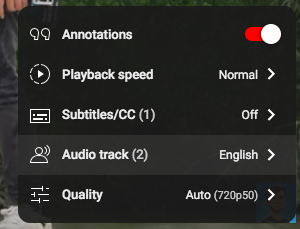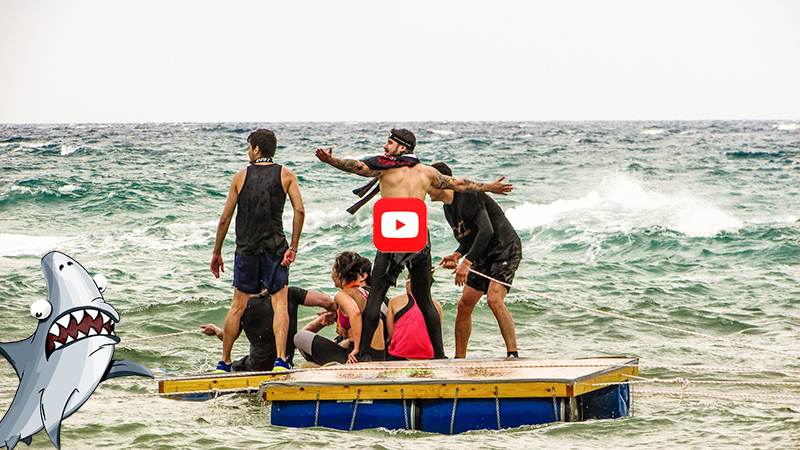Youtube dubbing by Atenao for Amixem’s Video “We Built a Raft”
Atenao Translation & Interpreting Agency has become the first language service provider to dub a French YouTube video using the new multi-language audio feature, thanks to our work on Amixem’s video “WE BUILT A RAFT (and we got caught by a storm!)”
How did YouTube blow the competition out of the water with its new youtube dubbing feature?
Up until earlier this year, dubbing videos on YouTube, Tiktok, Vimeo and other platforms meant uploading as many videos as there were languages. Each foreign language audio track had to be hard-coded into the video to replace the original audio.
This meant:
- A reduced number of views for the videographers;
- A massive increase in workload;
- Huge storage constraints for video platforms.
However, in early 2023, YouTube shook up the market (and safeguarded its position ahead of its competitors) by introducing dubbing in other languages to its videos. This new feature is a gateway to increased international reach, better view rankings and huge growth, as YouTube guru Mr Beast explains in his video on the subject. It was first tested by a small number of highly-popular content creators, including Mr Beast (who was the first user to showcase the new feature), and multi-language audio is now scheduled to be rolled out to thousands of other channels. In January alone, users watched a daily average of more than 2 million hours of video online. Since then, the new feature has been adopted by thousands more content creators, who have already uploaded more than 3,500 multi-language videos in over 40 languages. It is only a matter of time before all users are able to upload multi-language content.
How does it work?
The method can be summed up in 4 steps:
- Transcription of the texts;
- Translation of said texts;
- Voice recordings;
- Adding audio tracks through the YouTube Studio editor.
In reality, this is of course easier said than done, but rest assured that we will let you in on all the details about how Atenao dubbed Amixem’s video a little later.
Viewers can now choose their preferred language by going to the “Audio track” button in the video settings, just below the “Subtitles/ CC” button. This presents them with a myriad of choices of content that they previously would not have been able to watch.
The different languages are numbered in a drop-down list. This feature allows viewers to choose between the original version, or the version which has been dubbed in their language.

Amixem and Atenao in a boat…
Amixem’s take on the classic shipwreck scenario is already set to be Atenao’s most exciting adventure this year.
Boasting more than 8 million followers, 800 videos and a total of around 2.8 billion views, Amixem is one of the top 10 French YouTubers, hovering somewhere around the 6th to 8th position depending on rankings. You can therefore imagine the excitement in the office when Amixem contacted us! Our first reaction was to celebrate this big first for a French YouTuber, an opportunity which we couldn’t possibly turn down. Our second reaction, after the initial exhilaration, was one of slight concern. The end result had to be perfect; there was no way we could miss the mark on this project. Obviously, this set the bar (and our anxiety levels) quite high.
It should be noted that behind the little “Audio track” button on YouTube is an entire dubbing process that needs to be carried out; a time-consuming and complicated process, all the more so when the video comes from one of France’s top YouTubers and throws the following into the mix:
- Several different speakers.
- All speaking extremely quickly.
- Jokes, banter and puns galore.
- Onomatopoeia and raucous laughter.
- All sorts of cuts, splices and transitions.
But luckily, here at Atenao we know what we’re doing, and we don’t shy away from a challenge. It wasn’t our first dubbing job, and we knew our way around the process which we had perfected over the years. After the obligatory first step of setting out the project roadmap, it was time to choose the voice samples which would be sent to the client for validation.
- For Amixem, the main speaker and chilled-out boss of the group, a lively, spirited voice with lightning-fast delivery was called for.
- For Étienne, the group’s motor sports and DIY specialist, provider of manual skills and tips for the rest of crew, we chose a voice actor whose manly tone would embody confidence and reassurance.
- For Thomas, a professional comedian with a tendency to arcane humour and the least likely of the group to get his hands dirty, we needed a voice actor who would be able to convey swift mood changes and go from one extreme to another.
- For Yvan, the easily distracted (and somewhat hyperactive) dreamer of the group who makes one silly mistake after another, we needed a snappy, dynamic voice with a softer side.
- And finally, for special guest Stéphane, who we don’t see as much of on camera, the English voice was recorded by the voice actor behind one of the other main voices (maybe you can guess which one?).
We apparently made the right choices, as after a couple of small tweaks the panel of voice actors was green-lighted.
The journey from onboarding the translation team to the final recording
In translation, dubbing is always somewhat of a challenge. The texts can be neither literally translated, nor transcreated. The only option is a faithful and accurate translation, which, contrary to popular belief, is no mean feat. In this type of highly structured translation, there is very little artistic freedom:
- Strict timing. Despite the length of content varying between languages, the translated text must be around the same length as the original text. This to avoid any overlaps or gaps.
- Lip-synching. Even though the work carried out was more similar to a voice-over, the translation could not be too far removed from what was being said on screen, to avoid the crudely-dubbed spaghetti western effect. For the translator, this required checking each sentence to check that the lip-synching was, if not perfect, at least not an issue.
- Maintaining the relaxed, friendly style of the original French audio in the translation.
- Making sure that the jokes, puns, banter and onomatopoeia made sense in the target language.
On the technical side of things, the translators worked simultaneously on the voice-over and the subtitle frameworks, to make sure that the segmentation was homogeneous and to avoid unnecessarily translating the same texts twice. The document was then processed by a Computer Aided Translation (CAT) tool.
The framework contained:
- The texts for translation;
- A colour code for each speaker;
- Contextual information;
- Comments on the tone used;
- Any laughter, crying, singing, or other noises that the voice actors needed to record.
After approval of the script and the translations, the framework document and the audio tracks were sent to the voice actors, who had to synchronise their voice-overs in a single audio track. Once this step was completed, preliminary post-production could be carried out to assure quality control and make minor changes to the first version before it was sent to the client.
For the second version, some parts needed to be re-recorded and adjustments were made to the timing, to perfectly match the voices in English to the original French.
There were, of course, a few surprises along the way.
- Amixem speaks very quickly during the introduction, which made it tricky to fit in the English voice-over;
- The laughter was difficult to replicate, especially when all 4 people were speaking at the same time;
- Some cultural references were specifically French, and some words had no direct equivalent;
- It was sometimes difficult to make out the original audio over the sound of rain or loud voices.
- Luckily, each speaker had a separate microphone, and therefore a separate audio track.
Mission accomplished
Atenao was waiting with bated breath for the video release on 25 June 2023. The number of views started to climb and the comments were coming in thick and fast… so far, so good! The video had reached 4.2 million views and 219,000 likes by 5 September 2023, and the comments on the dubbing were very positive.
Who might need youtube dubbing in other languages, and why?
The launch of the multi-language audio feature on YouTube has opened up opportunities for the platform and for its users. YouTube maintains its industry pole position by increasing its global reach, and content creators can target this international audience. Language service providers are in an excellent position to penetrate this market, although competition with automatic AI dubbing, which YouTube intends to roll out soon, will be fierce. We tried out the first-of-its-kind service and the result isn’t bad, especially for a new type of technology. This means that dubbing could become the norm for all users creating content that could be relevant to international viewers. Dubbing may, one day, even replace subtitling.
The reality is that when it comes to translation, 90% of users who don’t have access to or don’t need a quality translation will probably adopt this new service, fuelled by AI.
But for those who are looking for a higher level of quality, and who have access to dubbing techniques (translation, recording, editing, etc.) and the budget that goes with them, professional dubbing recorded by a native-language, human voice actor is still the best option. This ensures that the format of the source audio is respected, thereby guaranteeing high-quality content. Atenao has all the necessary skills and resources to handle dubbing into other languages for YouTube, so if you think we might be able to help you… Get in touch!







